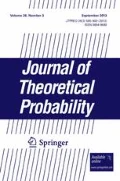Erratum to: J Theor Probab DOI 10.1007/s10959-013-0490-3
In the original publication of this paper, we fix a constant \(\mathbf{K} > 1\) and consider the set \(\mathcal {K}(\mathbf{K})\) of functions \(K : \mathbb {Z} \rightarrow \mathbb {R}^+\) satisfying the following conditions:
Unfortunately, the two first conditions readily imply \(K = 1\) since the operator \(\mathcal {R}\) is markovian, so that the three above conditions cannot be satisfied simultaneously.
In fact, we will simply consider the function \(K : s \mapsto \mathbf{K}^x\). The only one reason for the condition \(\mathcal {R}K(x) \le 1\) appeared in the proof of Fact 4.4.1, where the peripherical spectrum of the operators \(\mathcal {R}_s\) for \(|s| = 1\) and \(s \ne 1\) is controlled. With this new choice of function \(K\), one gets
Fact 4.4.1 For \(|s| = 1\) and \(s \ne 1\) one gets \(\Vert \mathcal {R}_s\Vert _K < 1;\) in particular, the spectral radius of \(\mathcal {R}_s\) on \((\mathbb {C}_0^\mathbb {N}, \Vert \cdot \Vert _K)\) is \(<\) 1.
Proof
We could adapt the proof proposed in the paper and show that \(\Vert \mathcal {R}_s^{2n}\Vert _K \le C \rho _s^n\) for some \(\rho _s < 1\) when \(s \ne 1\). We propose here another simpler argument.
Recall that \(\mathcal {R}_s\) acts from \((\mathbb {C}^N,|\cdot |_K)\) into \((\mathbb {C}^N,|\cdot |_\infty )\) and that the identity map is compact from \((\mathbb {C}^N,|\cdot |_\infty )\) into \((\mathbb {C}^N,|\cdot |_K)\). Consequently, the operator \(\mathcal {R}_K\) is compact on \((\mathbb {C}^N,|\cdot |_K)\) with spectral radius \(\le \)1 since it has bounded powers.
Let us fix \(s \in {\mathbb {C}} \backslash \{1\}\) with modulus 1 and assume that \(\mathcal {R}_s\) has spectral radius 1 on \((\mathbb {C}^N,|\cdot |_K)\); since it is compact, there exists a sequence \(\mathbf{a} = (a_x)_{x\in \mathbb {Z}} \ne 0\) and \(\theta \in \mathbb {R}\) such that \(\mathcal {R}_s \mathbf{a} = e^{i\theta }\mathbf{a}\), i.e.
It follows that \(|a_y| = |a_0| \ne 0\) for any \(y \in \mathbb {Z}\) since \(\sum \nolimits _{y\in \mathbb {Z}} |\mathcal {R}_s(x, y)| \le \sum \nolimits _{y\in \mathbb {Z}} \mathcal {R}_s(x, y)=1\); without loss of generality, we may assume \(|a_y| = 1\), i.e. \(a_y = e^{i\alpha _y}\) for some \(\alpha _y \in \mathbb {R}\). The equality (2) may be thus rewritten
By convexity, using again the inequality \(\sum \nolimits _{y\in \mathbb {Z}} |\mathcal {R}_s(x, y)|\le \sum \nolimits _{y\in \mathbb {Z}} \mathcal {R}_s(x, y)=1\), one readily gets \(e^{i\alpha _y}=e^{i\theta }e^{i\alpha _x}\) for any \(x, y \in \mathbb {Z}\); consequently, \(e^{i\theta } = 1\), the sequence a is constant and \(R_s(x, y) = \mathcal {R}(x, y)\) for any \(x, y \in \mathbb {Z}\), which implies in particular \(s = 1\). This is a contradiction.\(\square \)
Acknowledgments
We thank here S. Gouezel, who pointed out to us the contradiction of the three conditions (1) and the fact that the \(\mathcal {R}_s\) are compact on (\(\mathbb {C}, |\cdot |_K\)).
Author information
Authors and Affiliations
Corresponding author
Additional information
The online version of the original article can be found under doi:10.1007/s10959-013-0490-3.
Rights and permissions
About this article
Cite this article
Essifi, R., Peigné, M. Erratum to: Return Probabilities for the Reflected Random Walk on \(\mathbb {N}_0\) . J Theor Probab 28, 1250–1251 (2015). https://doi.org/10.1007/s10959-014-0568-6
Published:
Issue Date:
DOI: https://doi.org/10.1007/s10959-014-0568-6

